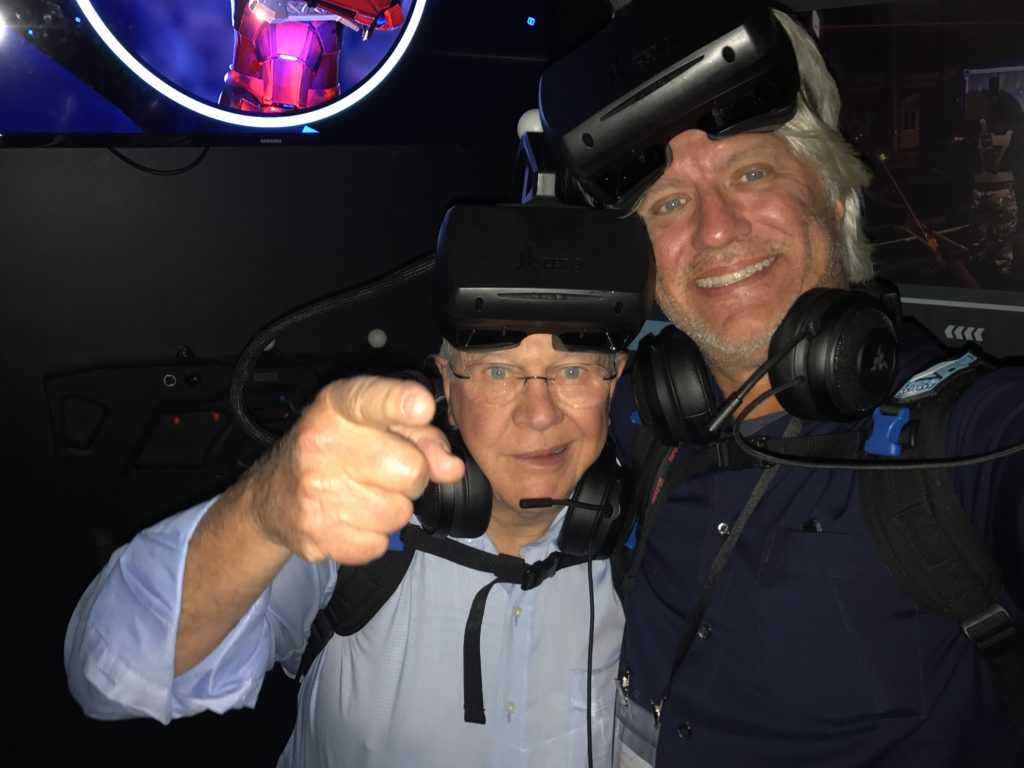What is Virtual Reality, Really?
Operator Adoption of Tech Could Spell Long-Term Developer Support
by Bob Cooney
TAt the IAAPA show last November, I was speaking with the GM of a family entertainment center about virtual reality attractions. They had recently purchased a Hologate, one of those 4-player, tethered VR systems with truss and lighting effects being distributed in the U.S. by Creative Works. We were standing in front of the Minority Media Chaos Jump booth, which is a product in the same category. She asked me, in all seriousness, “Why would I need another VR piece?”
I asked her, “How many arcade games do you have?”
“About 200,” she replied.
“Why don’t you have just one?”
She thought about that for a minute, and I was expecting an insightful answer. Instead I got back, “They’re all different.”
“Are they really,” I inquired? “Do you have Jurassic Park and Transformers and Walking Dead?”
“Why, yes I do!”
“Have you played them? They’re all basically the same game. They have the same game mechanic and core loop.” She started to frown. I continued, “What about Time Crisis and House of the Dead? Aren’t they the same? You shoot at a big screen? One has bad guys, the other zombies. And what about the redemption games? And prize vendors? How many different cranes do you have? What makes them different from each other?”
“Well, I see your point,” she relented.
“If you have an arcade filled with 200 games, many of which are the same, why do you think you only need one VR game?” I asked, only in part rhetorically.
One could say the same thing about pinball, but go tell an enthusiast that all pinball machines are the same, and you might wind up with a silver ball stuck in an orifice.
Too many operators are looking at VR like it’s a checkbox on their equipment list. “Okay, I have a VR now. I’m done.” That approach is due to a misunderstanding of what virtual reality really is.
VR isn’t a type of attraction. It’s a display technology that happens to be incredibly immersive.
Think back to the beginning of video games. They all used CRT monitors. Then along came rear-projection technology, and games like Alpine Racer and Prop Cycle emerged. But nobody in their right mind would have said, “Oh, I’ll only take one of those big screen games.” How dumb would that have sounded? I remember begging George Smith for as many of those as I could get in my Laser Storm centers when he was running Namco Cybertainment in 1995.
When rear-projection, large-format displays emerged in arcade games, it was all about deeper immersion. Instead of standing in front of a 27” piece of glass, you suddenly felt like you were inside the game. We all dreamed about being Tron, and those games got us closer than ever before.
Sure, there was VR back then, but the graphics were terrible and the lag was frustrating. Large format displays brought the action close in with high-resolution video so we could imagine what it was like to dive right into those worlds. Who didn’t play Alpine Racer and dream of being Jean Claude Killy or Alberto “La Bomba” Tomba?

Doug Trumbull, acclaimed director of 2001: A Space Odyssey, and Bob Cooney meet up with an artificial intelligence on an abandoned space station in a VR experience.
In 1996, I gave a keynote at Asian Amusement Expo explaining how those games were actually a version of “virtual reality” (the term “immersive entertainment” had yet to be coined). I talked about how VR was here to stay, but was coming in forms different than what people expected. It was coming in the form of motion simulators, dome theaters, projection screens and new forms of displays yet to be invented.
2019 finds us deep in the immersive barrel of the third wave of VR, which is providing the ultimate experience of being in the game. Virtual reality brings the experiences we’ve always dreamed about into your arcade or FEC. Now you can ride light cycles and throw discs in a life-or-death battle just like they did in the movie. You can also struggle to survive the zombie apocalypse, swim with whales, or as I did recently, explore an abandoned space station taken over by an artificial intelligence with Douglas Trumbull, the director of 2001: A Space Odyssey. (Do I have the best life or what?)
People play games to escape. VR provides the ultimate escape. So why aren’t more operators embracing it? They’re caught in FUD: fear, uncertainty and doubt.
“Is VR a fad?” I saw this technology in the 1990s and it died then. Maybe it will die again now. It’s too expensive. It’s too fragile. There aren’t enough games. What if the manufacturer goes under? I can’t charge enough to get my money back.” On and on and on. These fear-driven concerns are holding operators back from propelling the industry forward.
This limiting mindset is similar to one that existed back in 2001 when I gave a keynote at Fun Expo called “PC and Console Games: Is That Light at the End of the Tunnel, Or a Train?” (You can read about it here: https:// tinyurl.com/y3qoll3v.) Back then, I implored the industry to embrace the consumer games market and share the cash box with consumer game publishers so we could get the best games from the best developers. I had just licensed Tiger Woods PGA Tour Golf from Electronic Arts for Global VR. We gave them a percentage on every unit sold and a percentage of online play. And while we ultimately had to drop Tiger from the game (that’s a story for another article), it flipped the arcade-to-consumer-game model on its head.
In the good old days, the best arcade games were ported onto home consoles. As the consumer games market exploded, the best developers focused on the larger market, and the arcade video game business bordered on irrelevance. It was imperative for our industry to show a larger economic opportunity to game publishers in order to attract them back to our business.
But the idea of sharing the cash box to create windowed content really didn’t catch on. The resistance to revenue sharing was tangible. In one meeting with an operator, I was able to measure it by the volume of saliva on my face. And the video arcade business declined…greatly. Operators were forced to move hard into redemption games, shifting the emphasis from fun to merchandising. Sure, there were a few big games that would come out each year from companies like Namco and Sega, but the innovation in the video arcade business ground to a halt for 15 years.
But as my grandmother said, all good things come to those who wait. Slowly the industry has adopted revenue sharing. We can thank online tournaments from Incredible Technology and Play Mechanix, and digital jukeboxes from Touchtunes, Ecast and Rowe/AMi for that.
This time around, when VR emerged it caught the imagination of the game developer community like nothing before, and they started building games for the consumer market. But this market hasn’t quite developed for reasons I wrote about in my March 2017 piece in RePlay (it can also be found at www.replaymag.com/third-wave-of-vr-looks-like-a-tsunami-march-2017).
Without an installed base of virtual reality systems in the market, developers started shifting their attention to location-based entertainment as a way to create consumer awareness of VR (incorrectly assuming awareness was the problem) and to make enough money to extend their runways until the consumer market caught up with projections. Developers, not understanding the history of the amusement industry, demanded a percentage of the cash box. And since this was seen as a new product category, operators were open to it this time around.
Over the next five to 10 years, most (if not all) video arcade games will feature virtual reality displays. We will look back and wonder what all the fear was about. And we will have created a thriving ecosystem of operators, developers and manufacturers where everyone is driven by the same incentives: player engagement and cash box. But the only way that happens is if operators embrace the change now. Otherwise, the companies making VR games today will look towards other markets to make a living. And in 10 years, I will be writing about the fourth wave of VR. That would be a shame.
[Author’s note: If you’re looking to add VR to your business, but you’re not sure what to buy, or would like guidance on positioning, marketing, pricing or other strategies to maximize your ROI and minimize your risk, email me about my new operator mentoring program at vrbob@bobcooney.com.]
Electronic gaming and location-based entertainment veteran Bob Cooney helps companies with virtual and augmented reality solutions develop strategies to bring their products to the location-based entertainment market. He also helps operators navigate the stormy seas of disruption to select the best virtual reality solutions and experience for their locations. Bob has over 25 years of experience designing, manufacturing and marketing immersive out-of-home entertainment to consumers, operators and venues –– first as founder and chief executive of NASDAQ- and Inc. 500-listed Laser Storm, and later as an initial member of the Global VR executive team which introduced the first commercially viable virtual reality arcade game. Cooney went on to become VP of marketing and business development of Ecast, the digital content provider for jukeboxes, and COO of NTN Buzztime, the networked trivia game company. Cooney has been a driving force behind the development of numerous top-earning licensed games, including products based on EA Sports PGA Tour, X-MEN and Stargate, and has been a long-time vocal proponent of leveraging new technology to keep the out-of-home amusement industry relevant. To get in touch with Bob, visit www.bobcooney.com or email vrbob@bobcooney.com.




1 Comment
Pingback: VR and Your Location - What Makes Sense? - Bob Cooney